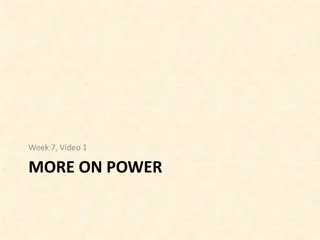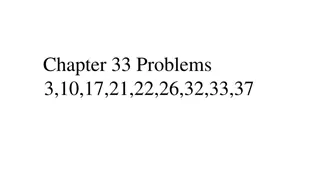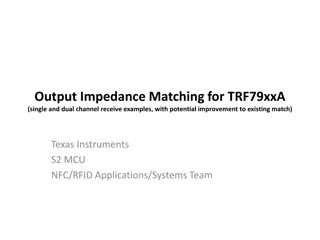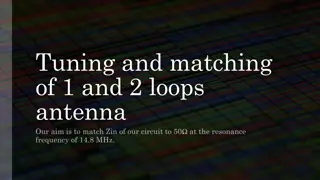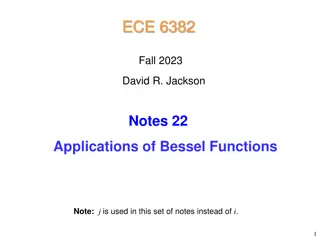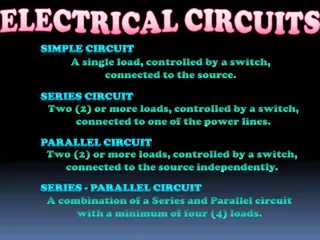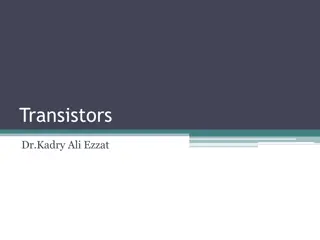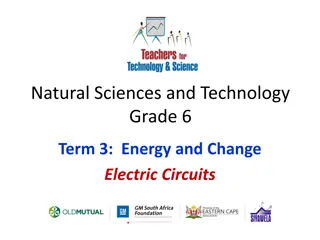Understanding Impedance and Phasor Diagrams in AC Circuits
Resistive elements in AC circuits exhibit zero phase shift between current and voltage due to their angles. Inductors introduce inductance when connected to AC sources, generating magnetic flux that affects conductor charges. Faraday and Lenz's laws explain induced voltage and current direction based on magnetic field changes.
Download Presentation

Please find below an Image/Link to download the presentation.
The content on the website is provided AS IS for your information and personal use only. It may not be sold, licensed, or shared on other websites without obtaining consent from the author. Download presentation by click this link. If you encounter any issues during the download, it is possible that the publisher has removed the file from their server.
E N D
Presentation Transcript
Lecture 2-5 IMPEDANCE AND THE PHASOR DIAGRAM 1
Resistive Elements The angle 0 of the resistance means that the resistance in an AC circuit causes a zero phase shift between the current passing through it and the supplied voltage . 2
Note: The physical meaning of representing the resistance as a vector of magnitude ? and of angle 0 is due to a truth that the current passes through the resistance is in-phase with the voltage of the source supplying it . This representation is suitable to treat the sinusoidal quantities (voltage and current) using vector algebra. 3
What is the Inductance? When a conducting wire wound in the manner shown in figure beside, it will be a Coil and it will be called an inductor ( ) because it behaves as an inductance ( ). The questions arise here are: What is this winding ( ) do? What it will induce? What happen when it is connected to a DC source? What happen when it is connected to an AC source? 5
Let us connect the coil to a DC source, then a current of constant magnitude ? pass through its wire, this will lead to generate a magnetic flux lines (in three dimensions 3-D), with a magnetic polarity as shown by the blue arrows in figure. They looks as if they rotate around the wire, while they are fixed in space. The free charges of the conductor will not be affected by this magnetic flux in this case, because, the free charge is not affected by a constant stationary magnetic field , then it will act as a resistance only. If this coil supplied by a sinusoidal current from an AC source, this current will generate a magnetic flux lines (in three dimensions), with variable magnitude and polarity. The free charges of the conductor will be affected by this magnetic flux in this case, because, the free charge is affected by a variable stationary magnetic field . This effect will be explained due to both Faraday s and Lenz s theorems as follows: ? ? DC 6
Faraday states that the variation of the magnitude of magnetic flux with time, affecting the coil leads to induce a terminal voltage ? .Also, he prove experimentally that the magnitude of this induced voltage is quantitatively determined due to the formula: ? = ??? ?? This Empirical Formula can be written as: ? = ?? ?? Or in the form: ? = ?? ?? Since, ? = ? = ?? = Flux Linkage. Lenz (1843) states that: If an induced current flows, its direction is always such that it will oppose the change which produced it. Also, it may be found as: when an emf is generated by a change in magnetic flux according to Faraday's Law, the polarity of the induced emf will produces a current that it's magnetic field opposes the change which produces it . Due to the above rules, it is clear that when a test charge exist in a place subjected to a variable magnetic field, this will cause that charge to move in a sense such that it will appose the change which produce this motion, as follows: 7
Eddy Currents ? ? Y x z When the flux decreasing ?? ?? The induced current rotates CW in a plain ? to ? in order to oppose the reduction in flux. When the flux increasing ?? ?? The induced current rotates CCW in a plain ? to ? in order to oppose the increase in flux. < 0 > 0 These induced currents are known as eddy currents ( ). Their motion in a short circuited loops in the conducting medium are the source of a heat and considered as: eddy current losses . 8
Due to Lenzs law, an eddy currents will be induced inside a copper wire of the coil affected by the stationary variable flux of the coil itself. The direction of the induced eddy current will be opposite to that of the supplied current when it increasing, and it will be in its direction when it is decreasing. Due to Faraday s Law, the induced voltage across the coil ? = ??? ??will be out of phase with the applied AC voltage across that coil. Hence, both Faraday and Lenz discuss the operation of the coil in that the induced emf causes an induced current (eddy currents) inside the coil due to its flux, leads to resist the current variation in it . To explain the behavior of an air-cored coil in an AC circuit, consider the following example: If an air-cored coil of ? turns supplied by a sinusoidal current ??? from an AC source by a sinusoidal voltage ??? , then the steady state rms value of the supplied current is ? . Hence, the steady state current formula is: ??? = 2 ? sin ?? Or 9
??? = ???? sin ?? Since, the relation between the flux ? ? and the current ? ? is linear in an air-cored coil due to the relations ??=? Then in general ? = /? And ? =?? ? ? Hence, ?? ? ??= ? ?? ? = ?? =????? ? ? ?? Since the current varies with time, then the flux varies with time too, then substitute ? ? above equation results in: ? ? =???? and ? ? in the ?? ?? ? ? ? Substitute ? ? and ? ? in Faraday s Law ? ? = ??? ? ?? 10
Results that ??? = ???2? ??? = ???2? ??? = ???2? ?? ? ? ?? ? ??????sin ?? ? ???? ? cos ?? ???2? ? represents the coil ? It is clear that the factor parameters, and can be denoted by the letter ? , then: ??? = ??????cos ?? The factor ?? will be denoted by ??, then: ??? = ??????cos ?? ??? = ????cos ?? ? known as the self inductance of the coil (H) ?? is the inductive reactance of the coil ( ) ?? ?? ?? The last equation represents the induced voltage across the coil denoted as ??? , which must be equal in magnitude and out of phase with the voltage source ?? in steady state. It is clear now that the current of the pure inductive load lags the source voltage by ?? , and leads that across the inductance by ?? . Due to its behavior, the inductive reactance ??= ?? denoted as ??= ?? 90 = ??? because it leads the current through it to lag the supplied voltage by 90 . 11
To understand the behavior of the inductor during a complete cycle, let us consider the coil shown in figure with a steady state sinusoidal current ??? passing through it, ??? = ???? sin ?? This current will induce variable flux inside the coil affecting on the free charges in the material of the coil itself leads to induce current as follows: In the period from 0 to 90 as shown in figure: The current will be increased from zero to ????. The direction of this current will be [CW] due to the [R.H.R.], hence, the north pole of the coil will be downward. The current will generate an increasing flux of > 0 . This varying flux will affect on the free charges in the copper wire of the coil itself leading to a [CCW] motion of these charges due to Lenz s Law. This motion will be against the direction of ?? and lead to reduce it and generates a back emf ??= ? ?? ?? = ? ?? ?? . ?? ?? Then, as shown before: ?? S ??= ????cos ?? Hence, this voltage must be equal in magnitude and opposite in polarity w.r.t. the applied voltage ??, then it must be described as: ??=????cos ?? ?? ?? N From 0 to 90 The diagram and waveforms shown below, describe the behavior of the inductance during a complete cycle of current with its four periods at steady state. 12
1 ?? ?? 0.5 ?? 0 0 90 180 270 360 ?? ?? -0.5 ?? -1 Inc. Inc. Dec. Dec. Flux rate Load AC Source Source Load Source Load Load Source Source Load Power ?? S N S ?? ?? ?? N ?? ?? ?? ?? ?? ?? ?? ?? N N S S From 0 to 90 From 90 to 180 From 180 to 270 From 270 to 360 13
From the above analysis it seems clear the power will ? =? ? = ? to From transferred from source to load. ? =? ? to transferred from load to source. ? =? ? to transferred from source to load. ? =?? ? transferred from load to source, and so on. The net transferred power equal to zero in a pure inductive load. : the power ? ? ???? ? =? From : the power ? ? 3? 4 ? =?? From : the power ? 4 ? ? 2 ? = ? : the power From to ???? Discussion: This behavior of the inductance means that it will resist the flow of the current during halftime of the cycle (when it considered as a load) and it will assist him to flow during the rest of the time of the cycle (when it considered as a source). Hence, its behavior is not like that of the resistor. The net power consumed by the inductance is zero. 14
?? 15


